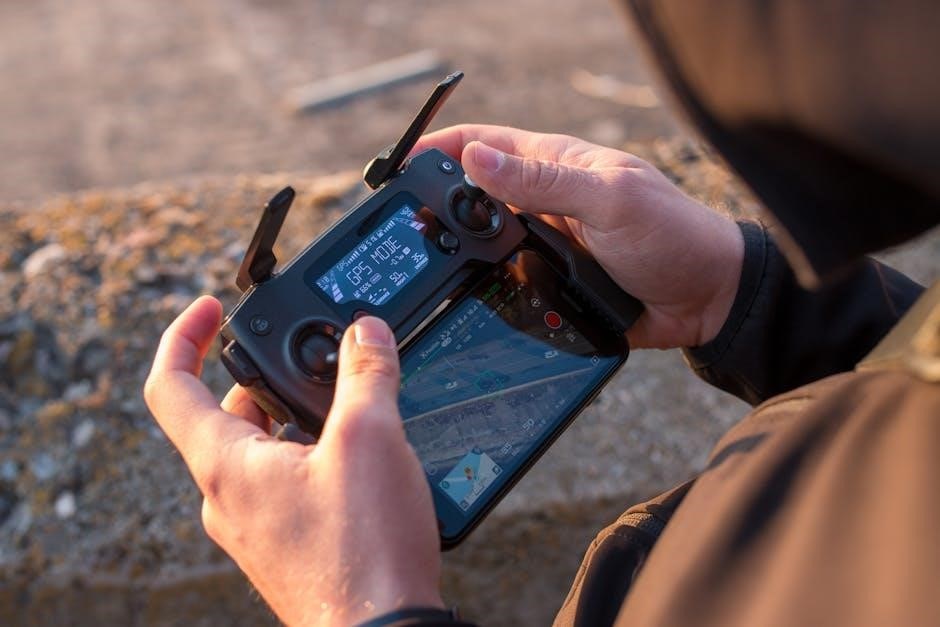Portable air conditioners offer convenient‚ mobile cooling solutions for various spaces. They operate by cooling indoor air and expelling heat outside through an exhaust hose. Proper installation and venting are crucial for optimal performance and efficiency.

Understanding How Portable Air Conditioners Work
Portable air conditioners use refrigerants to cool indoor air and expel heat outside through an exhaust hose‚ ensuring efficient cooling while maintaining a compact‚ mobile design.
The Cooling Process
Portable air conditioners draw warm air from the room into the unit‚ where it passes over refrigerated coils‚ cooling the air. The cooled air is then circulated back into the room. Simultaneously‚ the heat extracted during this process is transferred to the refrigerant‚ which carries it outside through the exhaust hose. Proper venting is essential to ensure the hot air is expelled efficiently‚ allowing the unit to maintain effective cooling. This continuous cycle of cooling and heat removal keeps the room at a comfortable temperature‚ making portable ACs a practical solution for spaces without central air systems.
Key Components of a Portable Air Conditioner
A portable air conditioner consists of several essential components that enable its operation. The compressor drives the cooling cycle‚ while the condenser and evaporator coils facilitate heat exchange. Refrigerant absorbs and releases heat‚ allowing the unit to cool the air. The fan circulates air through the unit‚ and the control panel manages settings like temperature and fan speed. A remote control provides convenient operation‚ and an air filter helps improve air quality. These components work together to ensure efficient cooling and ease of use in various spaces.
The Importance of Venting
Venting is crucial for portable air conditioners to function effectively; It allows the unit to expel hot air generated during the cooling process‚ ensuring efficient operation and preventing overheating. Proper venting through a window or alternative methods like sliding doors or exterior walls maintains performance and prevents energy waste. Without venting‚ the unit struggles to cool‚ leading to higher energy consumption and reduced effectiveness. Always ensure the exhaust hose is securely connected and vented outside to maximize cooling efficiency and maintain optimal room comfort.

Choosing the Right Portable Air Conditioner
Selecting the right portable AC involves considering room size‚ BTU requirements‚ and features like dehumidifying or heating modes. Ensure proper venting options are available for optimal performance.
Calculating the Correct BTU for Your Space
Calculating the correct BTU for your portable AC ensures efficient cooling. Measure your room’s square footage and consider factors like ceiling height‚ insulation‚ and the number of occupants. Use a BTU calculator or consult a sizing chart to determine the appropriate cooling capacity. Undersized units may struggle to cool effectively‚ while oversized units can lead to energy waste. Proper BTU matching ensures optimal performance and energy efficiency for your portable air conditioner.
Features to Consider for Optimal Performance
When selecting a portable air conditioner‚ consider features that enhance performance and convenience. Look for multiple cooling modes‚ oscillating louvers for even air distribution‚ and programmable timers for energy-saving operation. Energy efficiency ratings and adjustable thermostats can optimize power usage. Built-in air purifiers or ionizers improve air quality‚ while caster wheels and compact designs ensure easy mobility. Additional features like Wi-Fi connectivity and app control offer remote management‚ making it easier to maintain a comfortable environment. These features collectively ensure efficient cooling and user satisfaction.

Installation and Setup
Proper installation ensures efficient performance. Place the unit near a window‚ use the window adapter kit‚ and securely attach the exhaust hose to vent hot air outside effectively.
Selecting the Best Location for Your Portable AC
Choosing the right location is essential for optimal performance. Place the unit near a window and electrical outlet to facilitate easy venting and power connection. Ensure the area is unobstructed to maintain airflow. Avoid placing furniture or plants near the unit‚ as they may block air circulation. The location should also allow the exhaust hose to extend straight to the window without bending‚ ensuring efficient hot air expulsion. Proper positioning maximizes cooling efficiency and prevents potential safety hazards.
Using the Window Adapter Kit
The window adapter kit is essential for proper venting and cooling efficiency. Measure your window opening to ensure the adapter fits securely. Place the adapter in the window‚ adjusting its size if necessary. Secure it tightly to prevent gaps‚ using duct tape or additional materials like Plexiglas if needed. A snug fit ensures the exhaust hose connects properly‚ allowing hot air to escape outside. This step is critical for optimal performance and energy efficiency‚ preventing hot air from recirculating into the room.
Connecting the Exhaust Hose
Attach the exhaust hose to the portable air conditioner’s outlet‚ ensuring a secure connection to prevent air leaks. Extend the hose to reach the window adapter‚ keeping it straight to maintain airflow. Connect the other end to the window kit or adapter‚ sealing any gaps with provided panels or duct tape. This ensures hot air is efficiently expelled outside‚ optimizing cooling performance and energy efficiency. Proper connection is vital for effective operation and to prevent hot air recirculation.
Securing the Window Connection
After attaching the exhaust hose to the window adapter‚ adjust the window kit panels to snugly fit the window frame. Ensure no gaps remain by using the provided sliders or additional sealing materials like duct tape. Close the window gently to hold everything in place‚ preventing any movement or air leaks. A secure connection is essential for maintaining cooling efficiency and preventing hot air from re-entering the room. Proper sealing also ensures the unit operates quietly and effectively.
Alternative Venting Options
Beyond window venting‚ portable ACs can be vented through sliding glass doors‚ ceilings‚ or exterior walls with proper modifications. For ceiling venting‚ commercial kits are available‚ while exterior walls may require professional installation. Chimneys can also be used‚ ensuring they are clean and unobstructed. However‚ venting into attics is discouraged due to potential moisture buildup unless professionally assessed. Always prioritize efficient airflow and safety when exploring alternative venting solutions to maintain optimal cooling performance and avoid property damage.

Operating Your Portable Air Conditioner
Operate your portable AC by adjusting settings for efficiency‚ using the remote control for convenience‚ and ensuring proper airflow. Maximize cooling by insulating the hose‚ keeping it straight‚ and closing doors/windows. Plug in the unit near a window and outlet for optimal performance.
Adjusting Settings for Maximum Efficiency
To maximize efficiency‚ adjust the portable air conditioner’s cooling mode and fan speed based on room temperature. Use the remote control to conveniently regulate settings. Set the thermostat between 68-72°F for optimal cooling without overcooling. Enable eco-mode to save energy. Pre-cool the room before extreme heat sets in. Use timers to start cooling before you arrive. Ensure proper airflow by keeping the unit away from obstructions. Regularly clean filters to maintain performance. These adjustments ensure your portable AC runs efficiently‚ lowering energy bills and enhancing comfort.
Using the Remote Control Effectively
Mastering your portable air conditioner’s remote control enhances both comfort and efficiency. Use the power button wisely‚ considering energy-saving strategies like turning off the unit when not in use. Utilize the timer function to pre-cool your space‚ ensuring it’s comfortable upon your return. Experiment with modes—cool for active cooling‚ fan for air circulation‚ and dry to reduce humidity. Adjust fan speeds to balance cooling needs and energy use. Set the temperature between 68-72°F for optimal comfort. Explore features like eco-mode for energy savings and sleep mode for gradual temperature adjustments. Check for programmable settings or app integration for advanced control. Maintain remote functionality by replacing batteries promptly. For convenience‚ consider a remote with a backlight for ease of use in low-light conditions. By understanding and utilizing these features‚ you can maximize your AC’s performance while minimizing energy consumption.
Tips for Improving Cooling Performance
To enhance your portable AC’s cooling efficiency‚ ensure proper venting and seal gaps around the exhaust hose. Use fans to circulate cool air evenly and close doors/windows to maintain cool air. Regularly clean the air filter to improve airflow and check for blockages. Position the unit away from direct sunlight and heat sources. Insulate the exhaust hose to prevent heat loss and set the temperature between 68-72°F for optimal performance. Avoid overloading the unit and ensure it’s appropriately sized for your space. Finally‚ keep the room well-insulated to maximize cooling effects.

Maintenance and Care
Regular cleaning of the air filter and draining condensate water are essential. Store the unit properly during off-season and ensure all components are dry. This ensures longevity and efficiency.
Cleaning the Air Filter
Cleaning the air filter is essential for maintaining your portable air conditioner’s performance. Turn off the unit and remove the filter. Gently vacuum or wash it with mild soap. Allow it to dry completely before reinstalling. A clean filter ensures better airflow‚ energy efficiency‚ and cooling performance. Regular maintenance prevents dust buildup‚ which can reduce efficiency and increase energy bills. Clean the filter every 1-2 weeks‚ depending on usage‚ to keep your portable AC running smoothly and effectively.
Draining Condensate Water
Draining condensate water is crucial for maintaining your portable air conditioner’s efficiency and preventing leaks. Most units have a built-in tank that collects water. Check and empty it regularly‚ especially in humid climates. Some models feature a drainage hose or automatic shut-off when the tank is full. Always follow the manufacturer’s instructions for draining to avoid water damage or mold growth. Proper drainage ensures optimal performance and extends the unit’s lifespan. Regular checks prevent overflow and keep your space dry and comfortable.
Storing the Unit During Off-Season
Proper storage of your portable air conditioner during the off-season ensures optimal performance when it’s next used. Clean the unit thoroughly‚ including the air filter and exterior‚ to prevent dust buildup. Drain all condensate water to avoid mold or mildew growth. Store the unit in a dry‚ cool place away from direct sunlight and moisture. Cover the unit to protect it from dust‚ but avoid plastic covers that trap moisture. Keep it upright to maintain internal components. Finally‚ check the manufacturer’s instructions for specific storage recommendations to ensure longevity and efficiency.

Safety Precautions
Ensure the power cord is undamaged and avoid water exposure. Keep the unit away from flammable materials and ensure proper ventilation to prevent gas leaks or electrical hazards.
Electrical Safety Tips
Always ensure the power cord is undamaged and avoid using extension cords. Keep the unit away from water to prevent electrical shocks. Install the air conditioner on a firm‚ level surface and plug it directly into a grounded electrical outlet. Never modify the power cord or plug‚ as this can cause electrical hazards. Regularly inspect the cord for signs of wear or damage. Avoid overloading circuits‚ and ensure the unit is placed away from flammable materials. Following these guidelines helps prevent fire risks and ensures safe operation. Proper electrical practices are crucial for both safety and efficiency.
Handling Potential Issues
If your portable air conditioner isn’t cooling properly‚ check for blockages in the air filter or exhaust hose. Ensure the unit is correctly vented and the window seal is tight. If the unit isn’t turning on‚ verify that it’s properly plugged in and the circuit hasn’t tripped. For water leaks‚ inspect the condensate drain and ensure it’s functioning correctly. Regularly cleaning the filter and checking for kinks in the hose can prevent many issues. Always refer to the user manual for troubleshooting specific problems‚ and contact a professional if issues persist.

Common Questions and Misconceptions
Many users wonder if portable ACs must always be vented or if they can function without a hose. Others question venting into attics or alternative setups.
Do All Portable ACs Need to Be Vented Out a Window?
Yes‚ most portable ACs require venting to function properly. They expel hot air generated during cooling‚ typically through a window. Without venting‚ the unit cannot efficiently cool the room and may lead to increased humidity and energy bills. While alternative venting options like doors or attics exist‚ they often require special setups and professional advice to avoid issues like moisture buildup.
Can You Use a Portable AC Without a Hose?
Using a portable AC without a hose is not recommended‚ as it hinders the unit’s ability to expel hot air‚ reducing its cooling efficiency. Without proper venting‚ the room may become stuffy‚ and the AC will struggle to cool effectively‚ leading to higher energy consumption.
Is Venting a Portable AC Into the Attic Recommended?
Venting a portable AC into the attic is possible but generally not advised. It can introduce moisture‚ potentially causing mold growth or damage. This method is only suitable for attics designed to handle moisture. Consulting an HVAC expert is recommended to assess feasibility and avoid structural issues.

Troubleshooting Common Issues
Common issues with portable ACs include poor cooling‚ water leaks‚ or the unit not turning on. These problems often stem from improper venting‚ blocked filters‚ or electrical issues.

Why Your Portable AC Isn’t Cooling Properly
If your portable AC isn’t cooling effectively‚ it may be due to insufficient BTU capacity for the room size‚ blocked air filters‚ or improper venting. Ensure the unit is sized correctly for your space and that the exhaust hose isn’t kinked or obstructed. Check for a proper seal around the window adapter to prevent hot air from re-entering the room. Clean or replace the air filter if it’s dirty‚ as this can restrict airflow and reduce cooling efficiency. Lastly‚ confirm that the unit is properly vented outside to maintain optimal performance.
Fixing Leaks and Water Issues
Leaks and water issues in portable ACs often arise from improper drainage or condensation buildup. Check the drain system for blockages and ensure the unit is level to prevent water pooling. If water accumulates‚ turn off the AC and allow it to drain completely. For persistent leaks‚ inspect the exhaust hose for damage or kinks‚ which can disrupt airflow and cause condensation. Regularly clean the air filter to improve airflow and reduce moisture buildup. Consider using a drainage kit or external pan to manage excess water effectively.
What to Do If the Unit Isn’t Turning On
If your portable AC fails to turn on‚ first ensure it’s properly plugged into a functioning outlet. Check the circuit breaker to confirm it hasn’t tripped. Inspect the power cord for any damage or frays. Verify that the thermostat is set correctly and the remote control has working batteries. If issues persist‚ consult the user manual or contact an authorized service technician to diagnose potential internal faults‚ such as a faulty compressor or control board. Always prioritize safety and avoid attempting repairs beyond your expertise.
Portable air conditioners offer flexible cooling solutions‚ enhancing comfort and efficiency. Future trends include advanced energy-saving technologies and smarter controls‚ making them even more versatile and eco-friendly.
Final Tips for Getting the Most Out of Your Portable AC
To maximize efficiency and longevity‚ ensure proper venting and maintain a clean air filter. Use a timer to optimize energy usage and keep the unit away from direct sunlight. Insulate the exhaust hose in extreme temperatures and avoid bending it excessively. Regularly clean the filter to improve airflow and performance. By following these tips‚ you can enjoy consistent cooling while reducing energy costs. Always explore alternative venting options if window installation isn’t feasible.
Emerging Innovations in Portable Cooling Technology
Recent advancements in portable cooling technology include smart sensors for adaptive cooling‚ Wi-Fi connectivity for remote control‚ and eco-friendly refrigerants. Innovations like solar-powered units and improved hose designs enhance efficiency. These developments aim to provide quieter‚ more energy-efficient solutions while reducing environmental impact. Future trends may include self-evaporative systems and advanced dehumidification features‚ ensuring better performance in diverse climates. Such innovations are reshaping portable air conditioners into smarter‚ more sustainable cooling solutions for modern spaces.